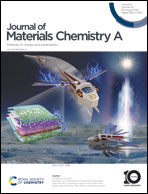Heteroatom P filling activates intrinsic S atomic sites of few-layered ZnIn2S4via modulation of H adsorption kinetics for sacrificial agent-free photocatalytic hydrogen evolution from pure water and seawater†
Abstract
The rational engineering of photocatalytic active sites on an atomic scale with regulated H adsorption energy and accelerated reaction kinetics has been pivotal to realize photocatalytic H2 evolution reactions (HERs) without sacrificial reagents. Although hydrogen evolution from pure water splitting is at the forefront of solar H2 research, photocatalytic seawater splitting is more in line with the notion of sustainable development owing to the limited resources of freshwater. Herein, we report for the first time an H adsorption kinetics-oriented design of two-dimensional (2D) hexagonal ZnIn2S4 (ZIS) atomic layers via heteroatom P doping (ZIS-P) for the modulation of intrinsic S active sites to achieve sacrificial agent-free photocatalytic HERs using both pure water and seawater. Atomic insights from density functional theory (DFT) calculations reveal that non-metal P dopants with different valence electrons and electronegativity than substituted S3 atoms in ZIS give rise to the formation of a new hybridized level with a moderately filled state near the valence band maximum (VBM) and impart redistribution of electron density within the coordination, hence triggering the activation of neighboring S2 atoms. Thus, ZIS-P with tailored S2 atomic sites and fine-tuned electronic structure endows a diminishment in H adsorption–desorption barriers and enables energetically favorable HERs. In particular, the optimal ZIS-P sample demonstrated visible light-driven photocatalytic water splitting without any sacrificial reagents, resulting in H2 evolution rates of 1.68 μmol h−1 (pure water) and 1.54 μmol h−1 (simulated seawater), respectively. This work presents an approach to engineer the inert active sites, thus alleviating the strength of H adsorption free energy and enhance the HER kinetics.

- This article is part of the themed collection: 2024 Journal of Materials Chemistry A Lunar New Year collection


 Please wait while we load your content...
Please wait while we load your content...